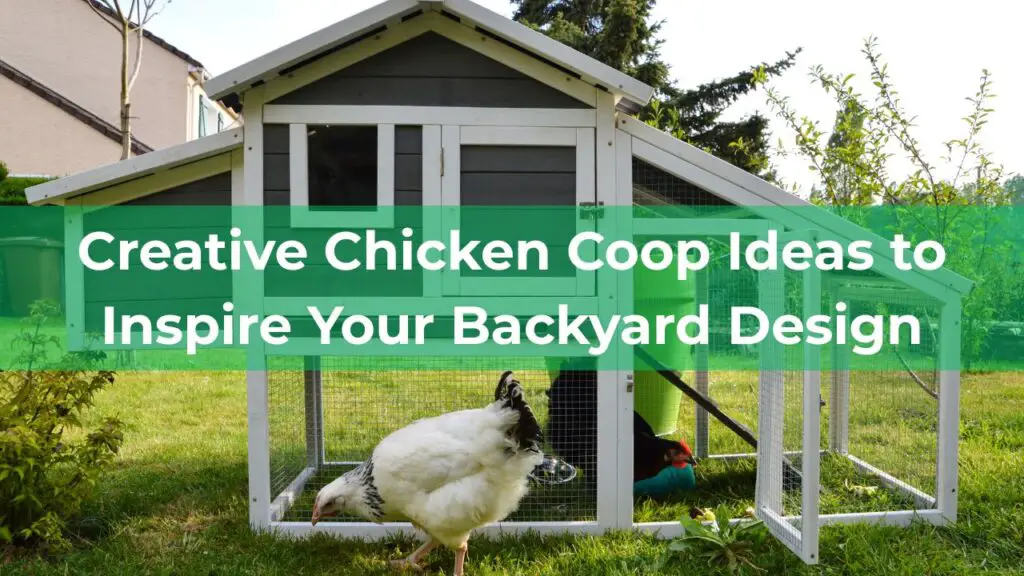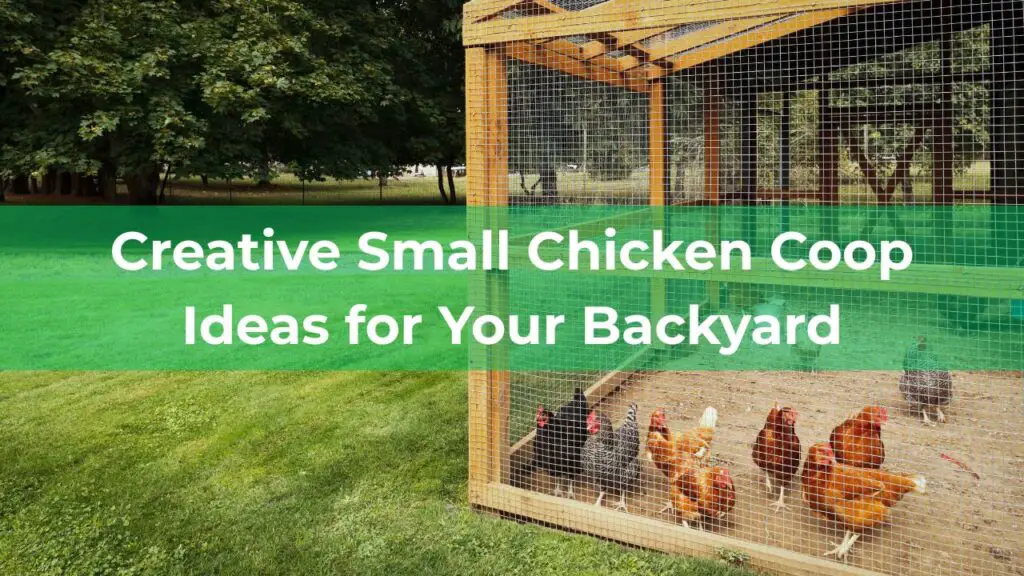Indoor plants are a fantastic way to liven up your living space while also improving air quality and bringing a touch of nature indoors. From low-maintenance succulents to vibrant flowering varieties, there’s a plant for every personality and skill level. Plus, they make for great conversation starters and can boost your mood, so why not give your home a little green love?
Pet-Friendly Indoor Plants to Brighten Your Home
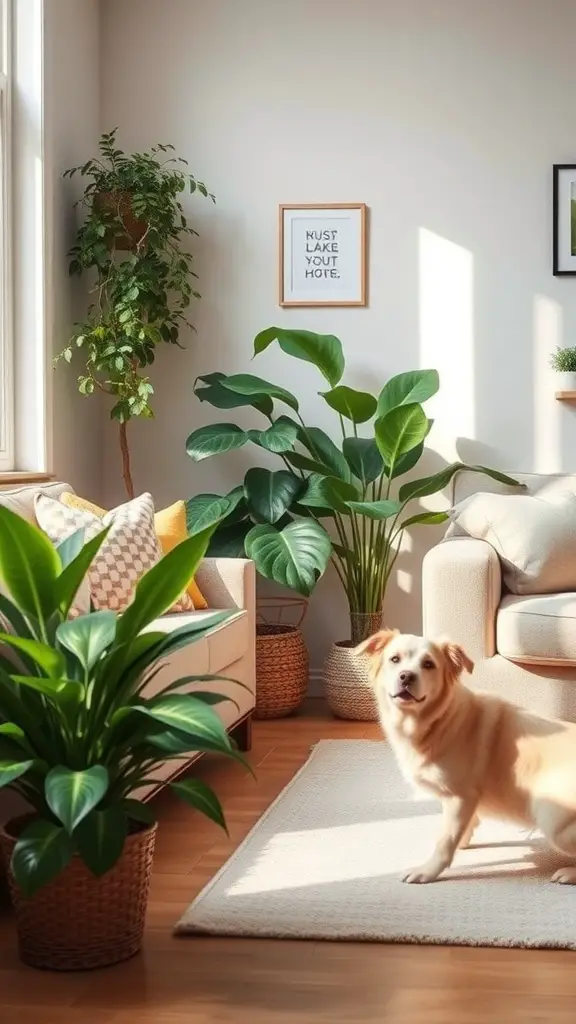
Bringing plants into your home can create a lively atmosphere. If you have pets, it’s essential to choose plants that are safe for them. The image shows a cozy living space filled with vibrant greenery and a happy dog, showcasing how plants can enhance your home.
Some great options include spider plants, Boston ferns, and parlor palms. These plants not only look good but are also non-toxic to pets. They thrive in various light conditions, making them easy to care for.
Incorporating these plants into your home can improve air quality and provide a natural touch. Plus, they can be a fun way to create a pet-friendly environment. Just imagine your furry friend lounging beside a lush plant!
Best Indoor Plants for Beginners
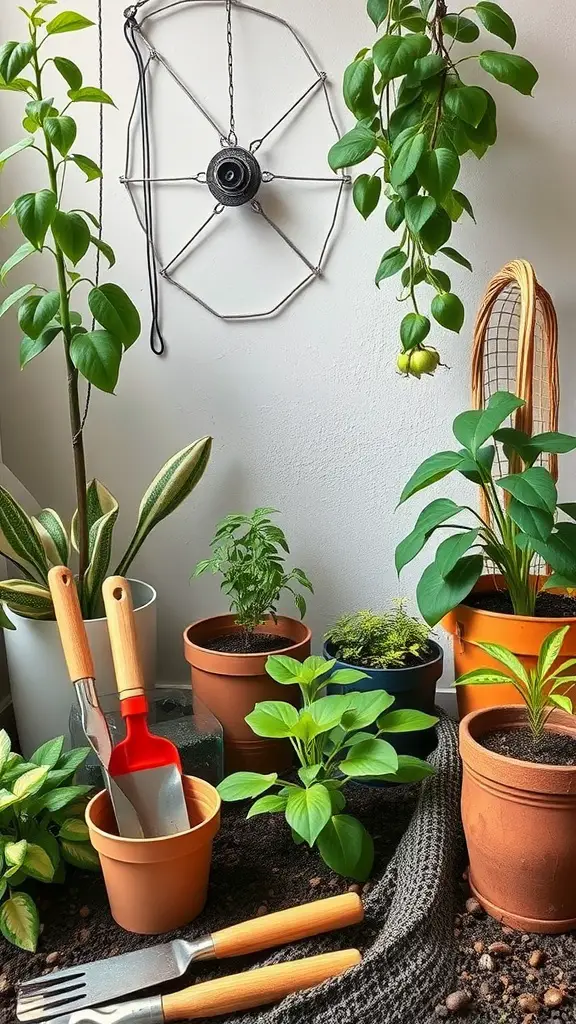
Indoor plants can brighten up any space and bring a touch of nature indoors. The image shows a cozy setup filled with various plants, pots, and gardening tools. This inviting scene is perfect for anyone looking to start their indoor gardening journey.
One of the easiest plants to care for is the pothos. Its trailing vines look great in hanging pots. Another beginner-friendly option is the snake plant, known for its striking leaves and ability to thrive in low light. Both of these plants require minimal maintenance, making them ideal for new plant parents.
In the image, you can also spot some smaller pots, which are perfect for herbs like basil or mint. These not only add greenery but can also enhance your cooking. The tools shown, like the trowel and fork, are essential for repotting and maintaining your plants.
Starting with a few easy-care plants can boost your confidence and make indoor gardening a fun hobby. With the right choices, your space can become a lush retreat.
Creating a Vertical Garden Indoors
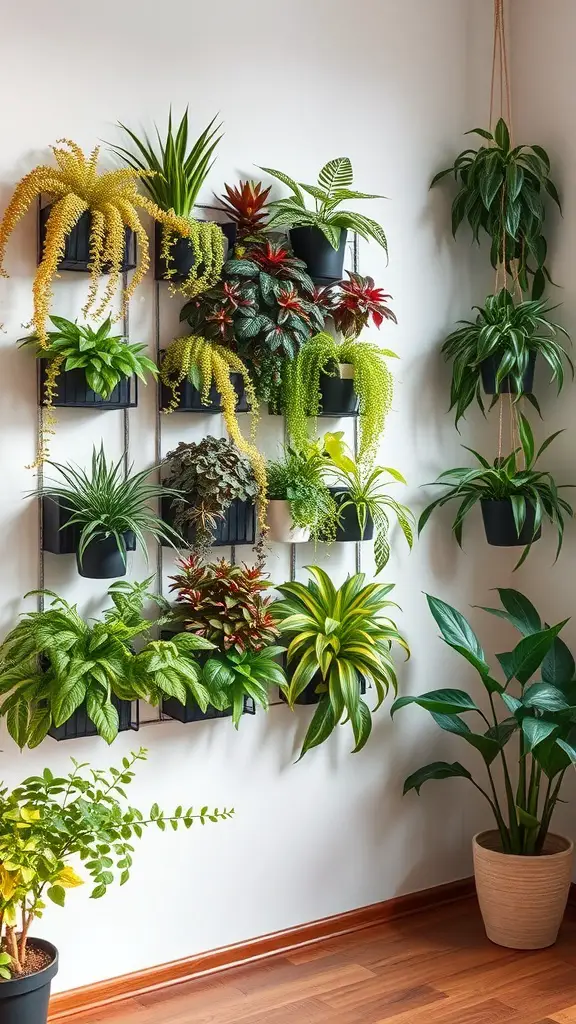
Vertical gardens are a fantastic way to bring nature inside. They save space and add a splash of color to any room. The image shows a beautifully arranged vertical garden with various plants. Each plant adds its unique texture and shade, creating a lively display.
To start your own vertical garden, choose a wall that gets some light. You can use shelves, wall-mounted planters, or even hanging pots. Make sure to pick plants that thrive in indoor conditions. Ferns, pothos, and peace lilies are great options.
Watering and maintenance are key. Check the moisture levels regularly and adjust based on the plant’s needs. This setup not only looks great but also improves air quality. It’s a win-win!
Low-Light Indoor Plants for Shady Spaces
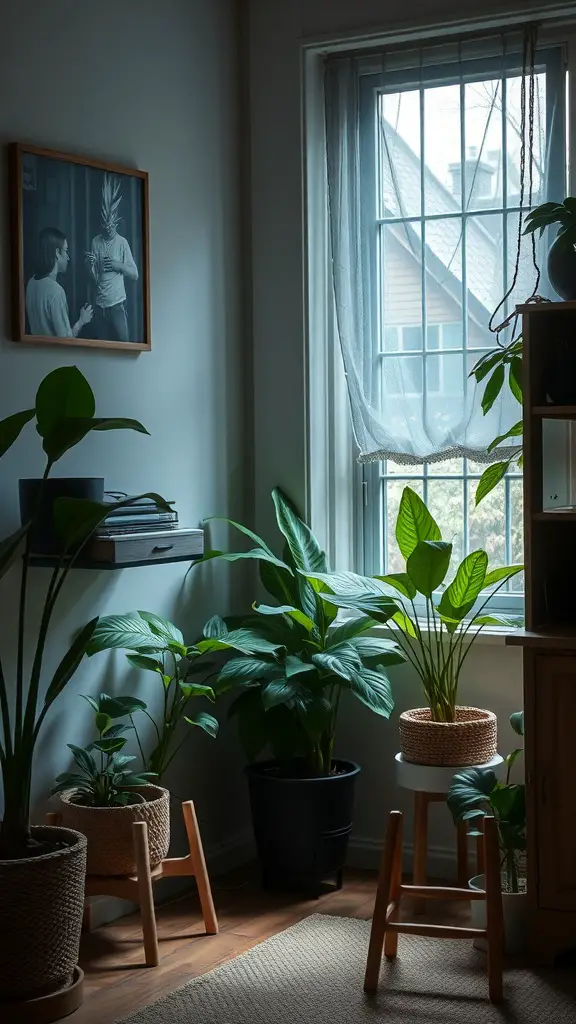
Indoor plants can brighten up any room, even those with limited light. The image shows a cozy corner filled with various plants, showcasing how greenery can thrive in low-light conditions.
In the scene, you can see large leafy plants that add a fresh touch to the space. The soft light filtering through the window highlights their vibrant green colors, making them stand out against the neutral walls.
Some popular low-light options include the Peace Lily and Snake Plant. These plants not only survive but also purify the air, making them perfect for indoor environments.
Arranging plants in different pots and heights, as seen in the image, creates visual interest. It’s a simple way to make a room feel more alive and inviting.
So, if you have a shady spot in your home, don’t hesitate to add some greenery. With the right plants, even the dimmest corners can become a little slice of nature.
Decorative Indoor Plant Stands and Shelves
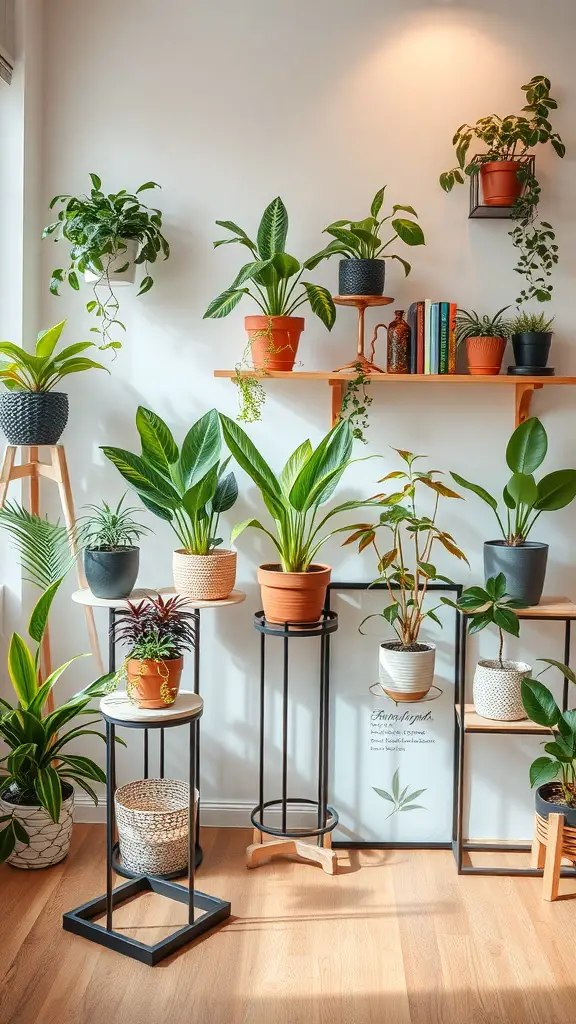
Indoor plants are a fantastic way to bring life into your home. Decorative plant stands and shelves can enhance their beauty while adding a stylish touch to your space. The image showcases a lovely arrangement of various plants on stands and shelves, creating a vibrant display.
Each plant has its own unique character, from leafy greens to colorful flowers. The stands vary in height and design, allowing for an eye-catching arrangement. This setup not only maximizes space but also highlights each plant’s features, making them the focal point of the room.
Using shelves and stands can help you create a mini indoor garden. It’s a great way to showcase your favorite plants and keep them organized. Plus, it makes watering and care easier. The mix of textures and colors in the pots adds to the overall charm, making your indoor space feel fresh and inviting.
Benefits of Indoor Plants for Air Quality
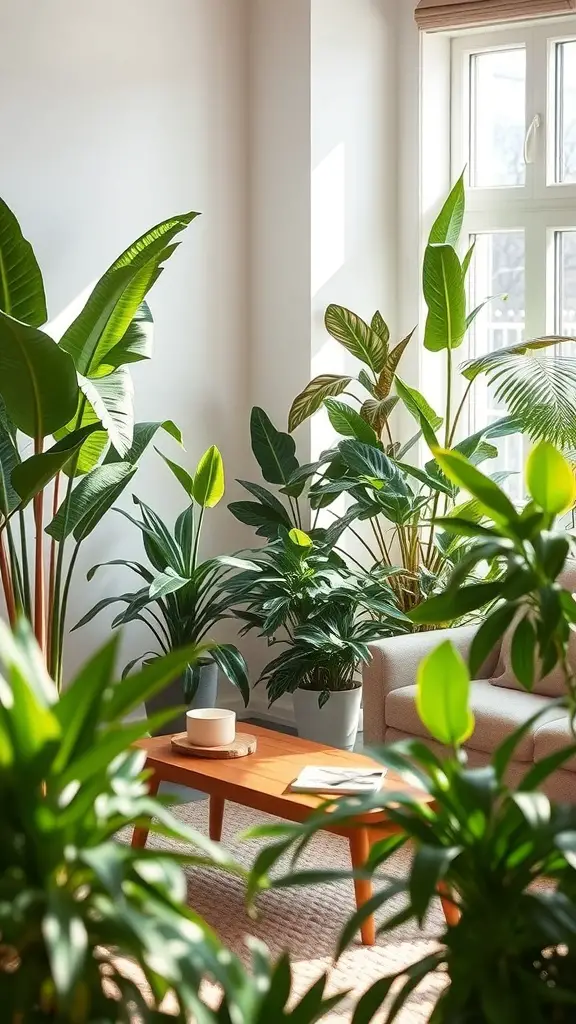
Indoor plants are more than just pretty decorations. They play a big role in improving air quality in our homes. The image shows a cozy room filled with various green plants, creating a refreshing atmosphere. These plants not only brighten up the space but also help filter the air we breathe.
Plants like peace lilies and snake plants are known for their air-purifying abilities. They absorb harmful toxins and release oxygen, making the air cleaner and healthier. This is especially important in indoor environments where air circulation can be limited.
Having a variety of plants, as seen in the image, can enhance this effect. Each type of plant contributes differently to air quality. For example, some can remove formaldehyde, while others tackle benzene. This diversity helps create a balanced and healthier living space.
Moreover, being around plants can boost your mood and reduce stress. The greenery can create a calming environment, making it easier to relax and unwind. So, not only do these plants clean the air, but they also improve your overall well-being.
Choosing the Right Potting Soil for Indoor Plants
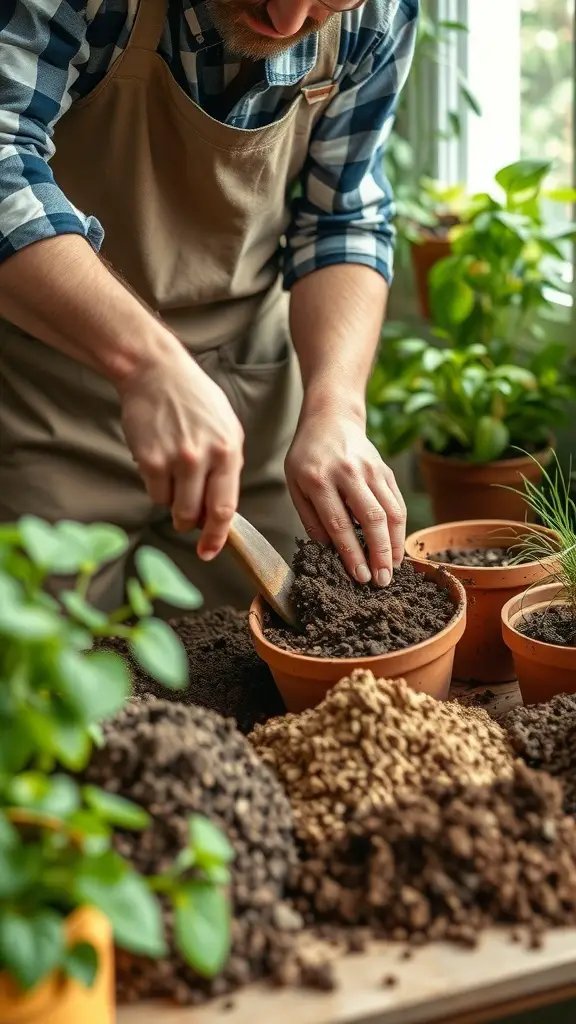
Picking the right potting soil is key to keeping your indoor plants happy and healthy. In the image, we see someone carefully preparing soil, surrounded by different types of potting mixes. This hands-on approach shows the importance of selecting the right blend for your plants.
There are many options when it comes to potting soil. Some mixes are designed for specific plants, like succulents or orchids. Others are more general-purpose. It’s good to know what your plants need. For example, succulents thrive in well-draining soil, while ferns prefer a moisture-retentive mix.
In the image, the person is using a scoop to fill a pot with soil. This simple act is a reminder that the right soil can make a big difference. It helps with drainage, aeration, and nutrient retention. Always look for a mix that suits your plant’s needs.
Don’t forget to check the ingredients! Organic options often contain beneficial microbes that help your plants grow. You might also see perlite or vermiculite in the mix, which improves drainage. Choosing the right potting soil can lead to thriving indoor plants that brighten up your space.
Caring for Succulents: Tips and Tricks
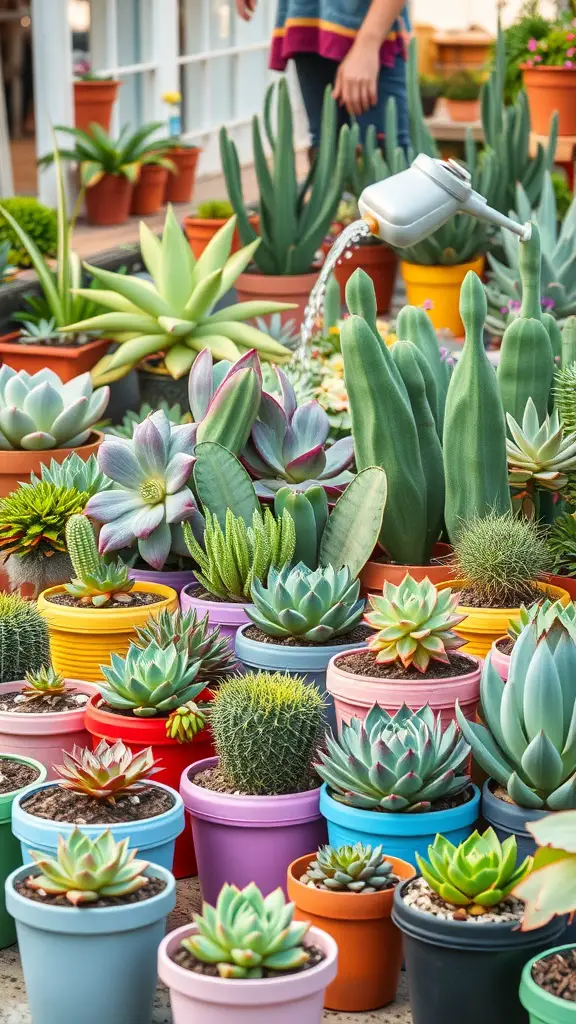
Succulents are charming plants that can brighten up any indoor space. The image shows a vibrant collection of various succulents in colorful pots. Each plant has its unique shape and color, making them visually appealing. A person is watering the plants, which highlights the importance of care in keeping these beauties healthy.
When caring for succulents, light is key. They thrive in bright, indirect sunlight. A sunny windowsill is often the perfect spot. If they don’t get enough light, they may stretch out and lose their compact shape.
Watering is another crucial aspect. Succulents prefer to dry out between waterings. It’s best to soak the soil and let it drain completely. Overwatering can lead to root rot, so always check the soil moisture first.
Fertilizing is not necessary for succulents, but a light feeding during the growing season can help them flourish. Use a diluted, balanced fertilizer to give them a little boost.
Lastly, repotting is something to keep in mind. As succulents grow, they may outgrow their pots. Choose a pot that is slightly larger and has good drainage to keep them happy.
Propagation Techniques for Indoor Plants
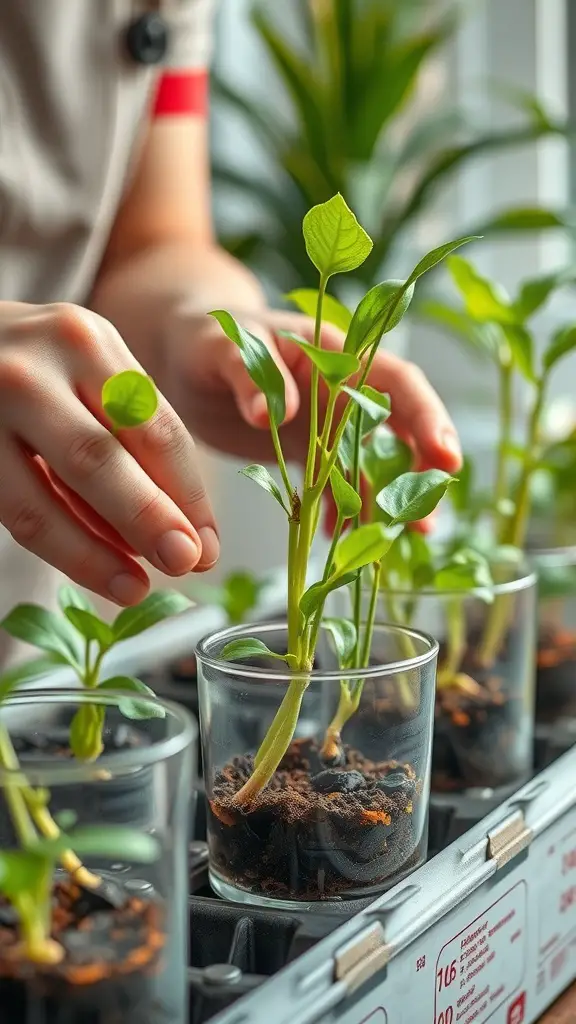
Propagation is a fun way to expand your indoor plant collection. The image shows someone carefully handling young plants in clear containers. This method allows you to see the roots as they grow, which is pretty cool!
One popular technique is stem cuttings. You simply cut a healthy stem from your plant and place it in water or soil. Make sure to choose a stem with a few leaves for the best results. After a few weeks, you’ll notice new roots forming.
Another method is division. This works well for plants that grow in clusters. You can gently separate the roots and replant them in new pots. Just ensure each division has some roots and leaves.
Lastly, layering is a neat trick for certain plants. You bend a stem down to the soil and cover part of it. This encourages it to root while still attached to the parent plant. Once it’s established, you can cut it free.
Indoor Plants for Improving Focus and Productivity
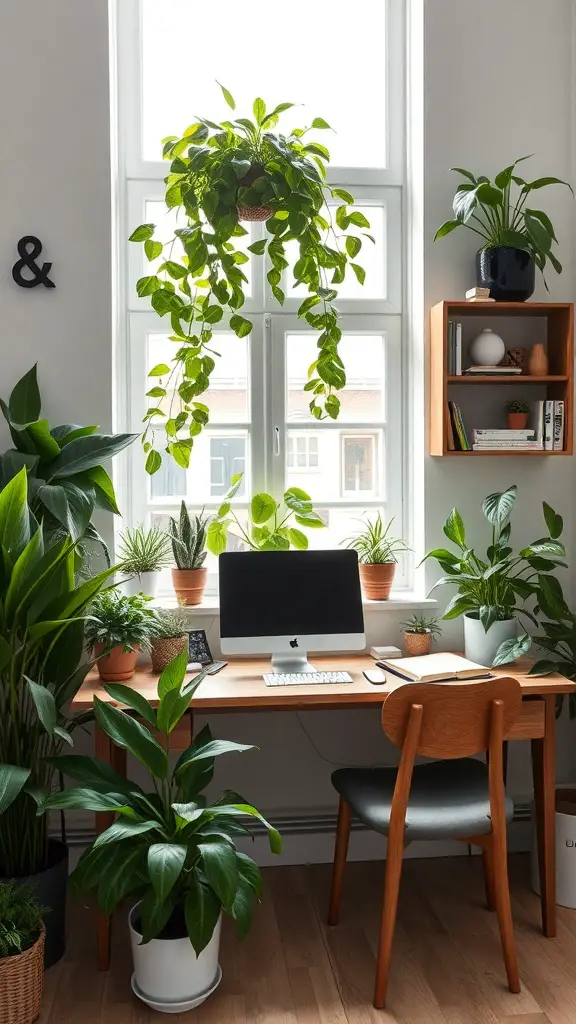
Indoor plants can truly transform your workspace. The image shows a cozy desk surrounded by various green plants, creating a refreshing atmosphere. A hanging plant cascades down from the window, while potted plants line the desk and shelves. This setup not only looks inviting but also boosts your mood and concentration.
Having plants nearby can help reduce stress and enhance your focus. Studies suggest that greenery in your environment can lead to increased productivity. The vibrant colors and natural textures of the plants can make your workspace feel more alive and engaging.
Consider adding low-maintenance plants like pothos or peace lilies. They thrive indoors and require minimal care. Positioning them near your computer or on your desk can create a calming effect, making it easier to tackle tasks. So, if you’re looking to enhance your work environment, think about incorporating some indoor plants!
Humidity and Temperature Needs of Indoor Plants
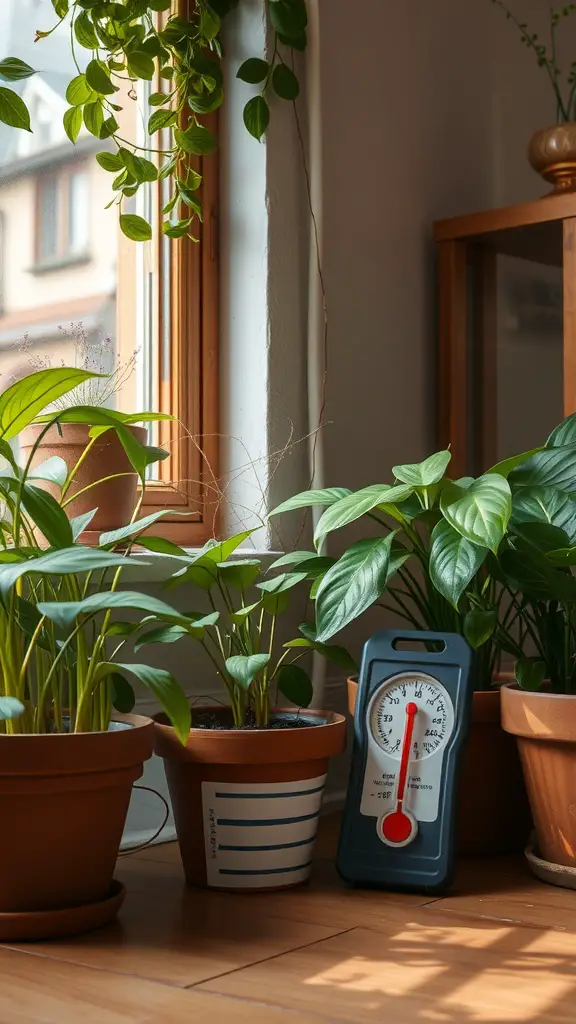
Indoor plants thrive best in specific humidity and temperature ranges. The image shows a cozy setup with various plants near a window, which is a great spot for them. The thermometer nearby indicates the importance of monitoring these conditions.
Most indoor plants prefer temperatures between 65°F and 75°F. This range mimics their natural habitat, allowing them to grow and flourish. Keeping an eye on the thermometer can help you maintain this ideal environment.
Humidity is equally important. Many houseplants enjoy humidity levels around 40% to 60%. If the air in your home is too dry, consider using a humidifier or placing a tray of water near your plants. The greenery in the image looks healthy, suggesting it’s in a good humidity zone.
Remember, different plants have different needs. Always check the specific requirements for your varieties. With the right care, your indoor plants can thrive and bring life to your space.
DIY Indoor Plant Care Schedule
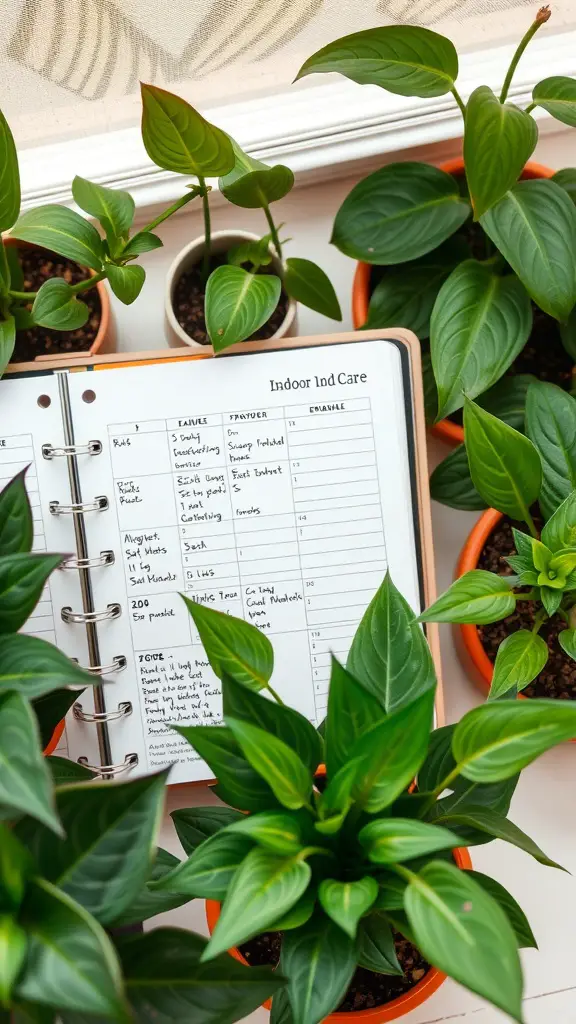
Creating a care schedule for your indoor plants can make a big difference in their health and happiness. The image shows a neat planner filled with helpful notes on plant care, surrounded by vibrant greenery. This setup is a great example of how organization can help you keep track of your plants’ needs.
In the planner, you can see sections for watering, light requirements, and other essential care tips. This makes it easy to remember what each plant needs. For instance, some plants thrive in bright light, while others prefer shade. By jotting these details down, you can avoid the guesswork.
Next to the planner, the lush green plants in terracotta pots add a lively touch. They remind us that caring for plants is not just a task; it’s a rewarding experience. Regularly checking on your plants and updating your care schedule can help them flourish.
So, grab a notebook and start your own indoor plant care schedule. It’s a fun way to connect with your plants and ensure they get the attention they deserve!
Creating a Zen Space with Indoor Plants
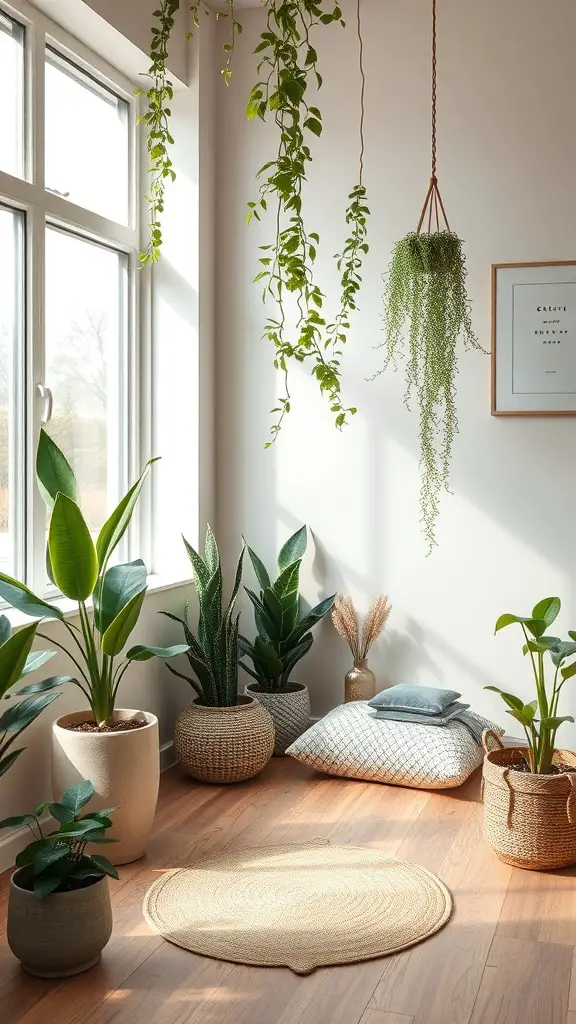
Indoor plants can transform any space into a calming retreat. The image shows a cozy corner filled with various plants, creating a serene atmosphere. The sunlight streaming through the window highlights the vibrant greens, making the room feel alive.
Notice the hanging plants that add a touch of whimsy. They draw the eye upward, making the space feel taller and more open. The combination of different plant types, from tall leafy ones to smaller potted varieties, creates visual interest.
The soft textures of the cushions and the round rug invite you to sit and relax. This setup encourages mindfulness, making it a perfect spot for meditation or simply enjoying a quiet moment. Incorporating plants like these can help reduce stress and improve air quality, enhancing your overall well-being.
Creating a Zen space is all about balance. Choose plants that resonate with you and arrange them in a way that feels harmonious. With a little thought, your indoor plants can help you cultivate a peaceful sanctuary right at home.
Seasonal Care for Indoor Plants
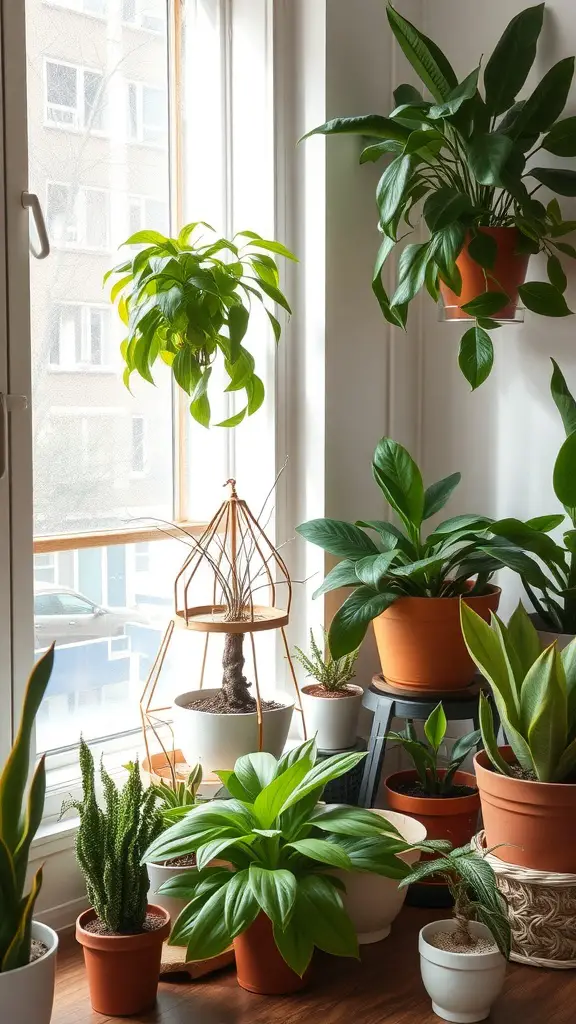
Indoor plants bring life to any space, and caring for them changes with the seasons. In the image, you can see a variety of plants thriving by a sunny window. This setup is perfect for seasonal care, as sunlight is crucial for their growth.
In spring, many plants start to grow more actively. This is the time to repot them if they’ve outgrown their containers. Use fresh soil to give them the nutrients they need. Regular watering is key, but make sure not to overdo it.
Summer is all about keeping your plants hydrated. The heat can dry out the soil quickly, so check moisture levels often. You might want to mist the leaves to keep humidity up, especially for tropical plants.
As fall approaches, reduce watering as many plants begin to slow down. This is a great time to clean the leaves to remove dust and allow them to absorb more light. You can also start to think about moving them away from direct sunlight if it gets too intense.
Winter can be tough for indoor plants. They need less water during this time. Make sure they’re not too close to heating vents, as dry air can be harmful. A little extra care, like rotating them for even light, can help them survive the colder months.
Common Pests and Diseases of Indoor Plants
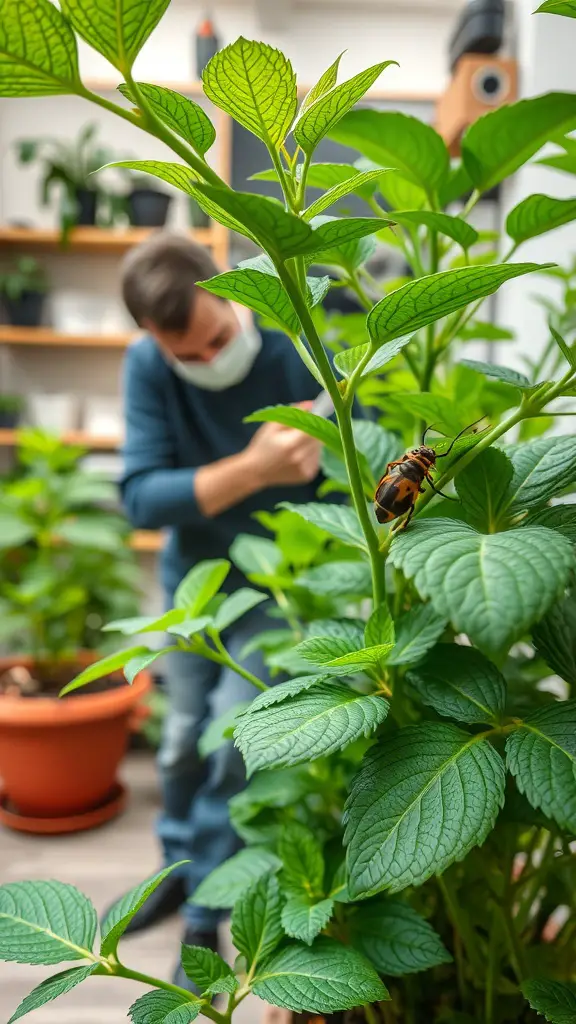
Indoor plants can bring life to any space, but they can also attract unwanted guests. In the image, we see a person inspecting a plant closely, likely checking for pests. This is a good practice for any plant owner.
Common pests include aphids, spider mites, and mealybugs. These tiny creatures can cause significant damage if not caught early. Regularly checking your plants helps you spot these pests before they multiply.
Diseases can also affect indoor plants. Fungal infections often thrive in humid conditions. If you notice yellowing leaves or spots, it might be time to investigate further. Keeping your plants clean and well-ventilated can help prevent these issues.
Using natural remedies or insecticidal soap can be effective against pests. Always try to identify the problem before treating it. A little attention goes a long way in keeping your indoor garden healthy and thriving.
Combining Indoor Plants with Home Decor
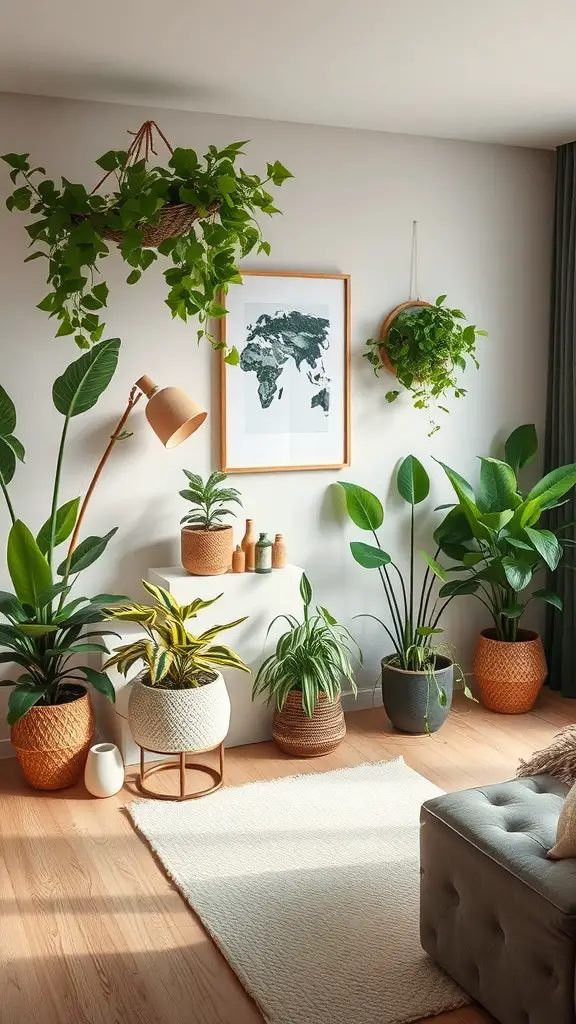
Indoor plants can truly bring a space to life. In the image, you can see a cozy corner filled with various plants, each adding its own charm. The mix of hanging and potted plants creates a lush, inviting atmosphere.
The choice of pots also plays a big role. The woven textures and earthy colors complement the greenery beautifully. This combination not only enhances the decor but also adds warmth to the room.
Notice how the plants are arranged? They create layers, drawing the eye around the space. The tall leaves of some plants contrast nicely with the smaller ones, making the area feel dynamic and full of life.
Incorporating art, like the framed map on the wall, ties the whole look together. It adds a personal touch while keeping the focus on the plants. This balance between decor and nature is what makes indoor gardening so appealing.
Indoor Plants That Flower
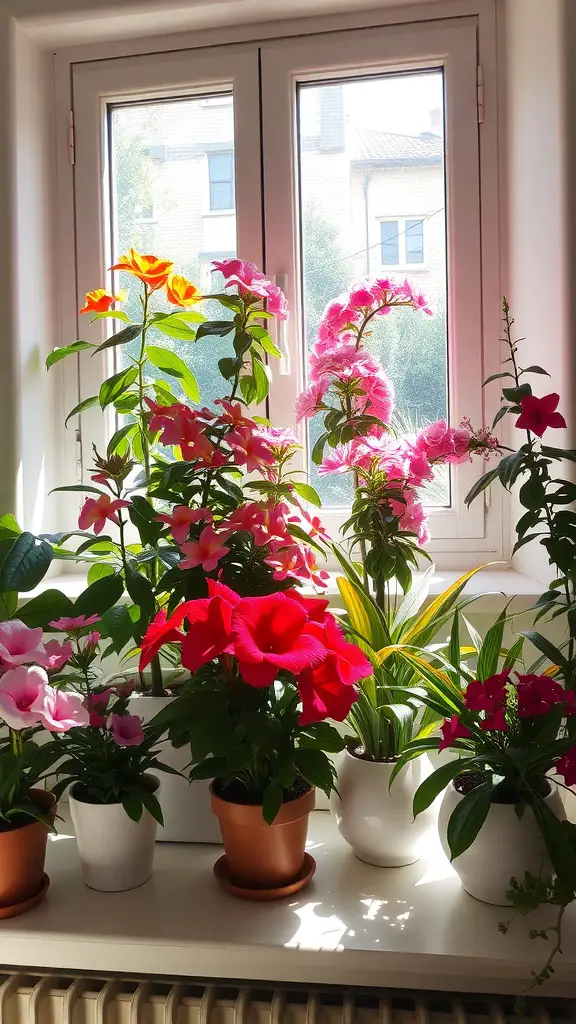
Indoor plants can bring a splash of color and life to any space. The image shows a beautiful collection of flowering plants, each showcasing vibrant blooms. These plants not only brighten up your home but also improve air quality.
The bright reds, pinks, and oranges in the image are eye-catching. They create a cheerful atmosphere, making any room feel more inviting. Flowering plants like these can thrive indoors with the right care.
Some popular choices include hibiscus, which can produce large, stunning flowers, and dipladenia, known for its lovely trumpet-shaped blooms. These plants often prefer bright, indirect sunlight, making a windowsill a perfect spot.
Watering needs vary, so it’s good to check the soil regularly. Keeping the plants healthy will ensure they continue to bloom beautifully. Adding flowering plants to your indoor garden is a simple way to enjoy nature’s beauty right at home.
Sustainable Practices for Indoor Plant Care
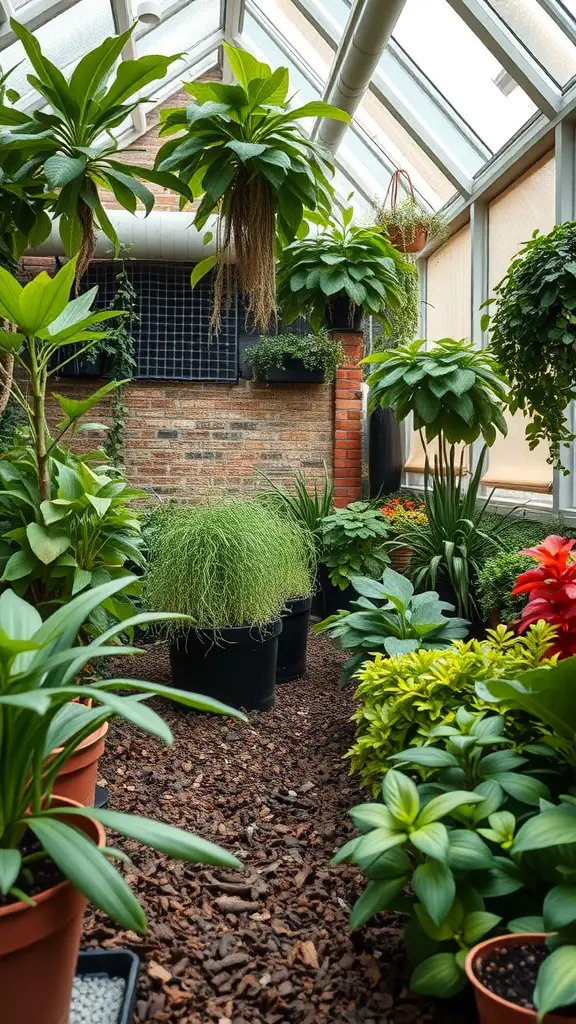
Indoor plants bring life to our spaces, and caring for them sustainably can make a big difference. The image shows a vibrant indoor garden filled with various plants, showcasing how lush greenery can thrive indoors. Each plant contributes to a healthier environment, purifying the air and adding beauty.
One simple way to practice sustainability is by using natural fertilizers. Composting kitchen scraps can provide nutrients for your plants without harmful chemicals. This not only helps your plants grow but also reduces waste.
Watering wisely is another key practice. Instead of daily watering, check the soil moisture first. This helps conserve water and prevents overwatering, which can harm your plants. Collecting rainwater is a great alternative, too!
Choosing native plants can also support local ecosystems. These plants are often easier to care for and require less water. They attract beneficial insects and can thrive in your indoor garden.
Lastly, repurposing old containers for planting is a fun way to reduce waste. Get creative with jars, cans, or even wooden crates. This not only adds character to your space but also promotes a sustainable lifestyle.
Maintaining Indoor Plants While Traveling
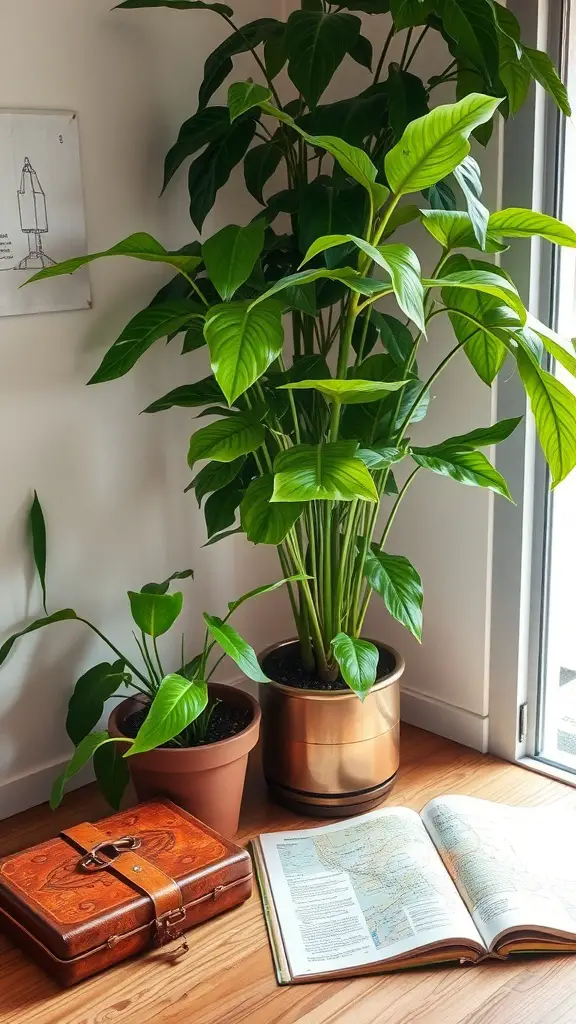
Traveling can be exciting, but it often raises concerns about your indoor plants. You want to make sure they stay healthy while you’re away. The image shows a cozy corner with vibrant plants, a travel bag, and a map, hinting at the journey ahead.
Before you leave, consider watering your plants thoroughly. This helps them stay hydrated for a longer period. If you’re going for an extended trip, you might want to use self-watering stakes or a drip system. These tools can provide a steady water supply.
Another tip is to group your plants together. This creates a mini ecosystem where they can help each other retain moisture. Placing them near a window is great, but make sure they won’t get too much direct sunlight while you’re gone.
Lastly, don’t forget to check the humidity levels in your home. If it’s low, consider using a pebble tray filled with water under your pots. This can help keep the air around your plants moist.
Choosing the Right Light for Indoor Plants
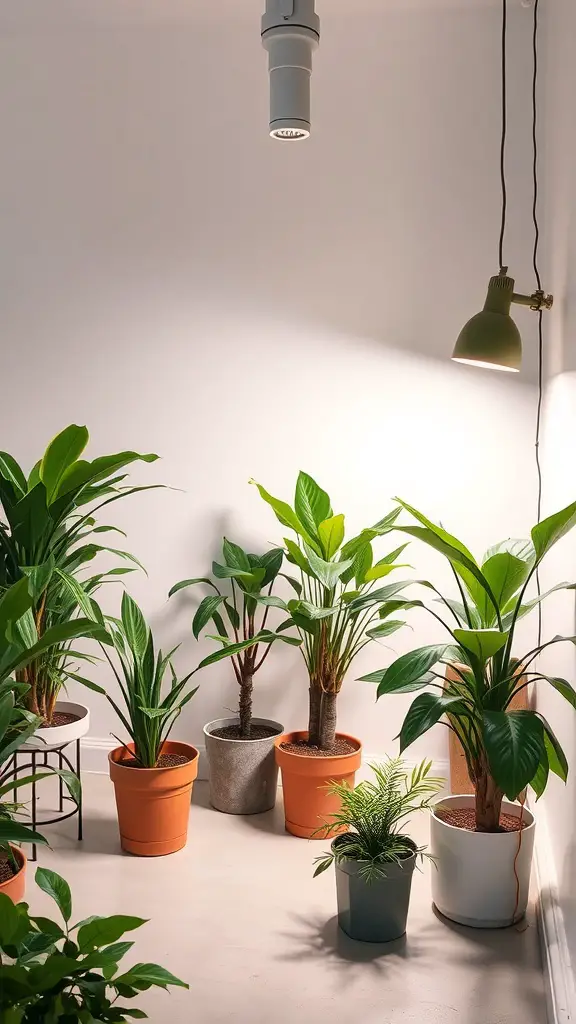
Indoor plants thrive on light, and choosing the right type is key to their health. The image shows a cozy corner filled with various plants, all basking under different light sources. Notice how the plants are arranged, with some getting direct light and others in a softer glow.
When picking light for your plants, think about their needs. Some plants love bright, direct sunlight, while others prefer indirect light. The overhead spotlight in the image is perfect for those sun-loving varieties, while the lamp provides a gentler touch for more delicate species.
It’s also important to consider the duration of light exposure. Most plants do well with about 12-16 hours of light each day. You can use timers to help manage this, ensuring your plants get the right amount of light without any guesswork.
Lastly, don’t forget about the color temperature of the light. Warm light can create a cozy atmosphere, while cooler light can promote growth. Experiment with different setups to find what works best for your indoor jungle!
Creating a Themed Indoor Plant Collection
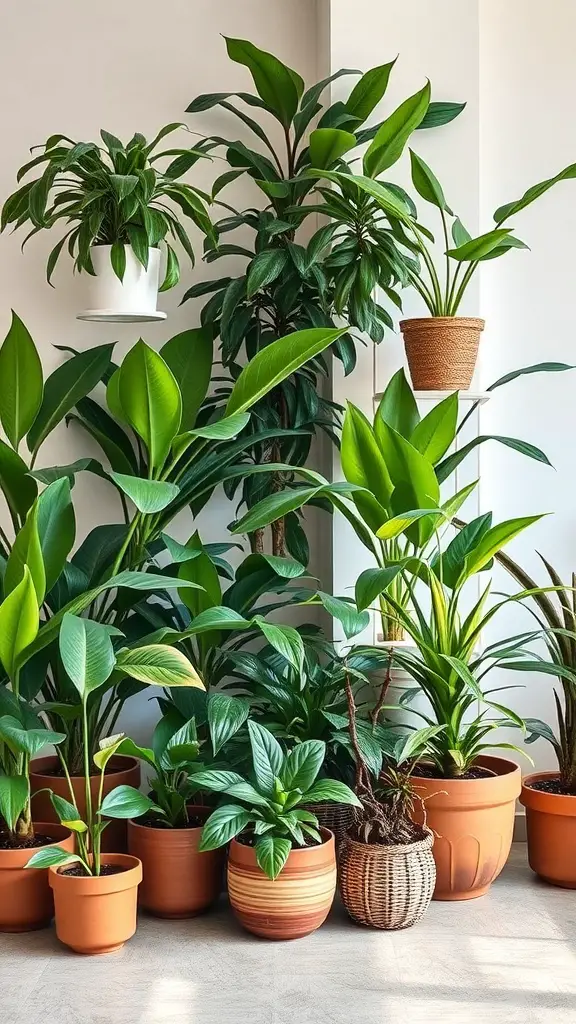
Creating a themed indoor plant collection can bring a fresh vibe to your space. Imagine a corner of your home filled with lush greenery, each plant chosen to complement the others. The image shows a variety of plants, each with unique shapes and sizes, arranged in a way that draws the eye.
Start by deciding on a theme. You might choose a tropical look with large leaves or a minimalist style with sleek, modern pots. The plants in the image, like the tall leafy ones and the smaller varieties, work together to create a balanced look. Mixing different heights adds depth and interest.
Consider the pots too! The earthy tones of terracotta and woven baskets in the image add warmth. You can mix and match pots to enhance your theme. Don’t forget about placement; taller plants can go in the back, while shorter ones can sit in front for a layered effect.
Finally, think about care requirements. Grouping plants with similar light and water needs makes maintenance easier. This way, your themed collection not only looks great but thrives too!

